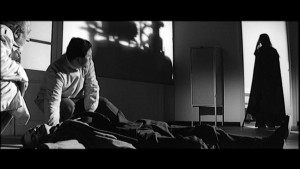Mario Bava’s I, Vampiri
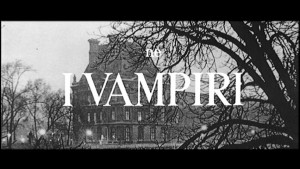 Here’s the idea behind “A Canadian, an American, and an Elitist”: Rhett’s favorite movie is Meatballs 4, Shawn has an unhealthy fixation on Resident Evil, and Adam is a prick who hates everything. We all watch far too many movies, and spend our time analyzing them. So we each watch the same movie, write our analysis of them, and then go to a chat room to discuss it, unaware of what the others have written. A warning: if you haven’t seen the film we are discussing, it may not be best to read this article, because it is spoiler heavy.
Here’s the idea behind “A Canadian, an American, and an Elitist”: Rhett’s favorite movie is Meatballs 4, Shawn has an unhealthy fixation on Resident Evil, and Adam is a prick who hates everything. We all watch far too many movies, and spend our time analyzing them. So we each watch the same movie, write our analysis of them, and then go to a chat room to discuss it, unaware of what the others have written. A warning: if you haven’t seen the film we are discussing, it may not be best to read this article, because it is spoiler heavy.
Within the chat, there are a number of citations of certain images and their corresponding placement in the film. I have done my best to match them up. In other words, when you see someone stating a time during the chat, the image to the left of the text is what it is referring to. This is only true in the chat portion of the piece. Click on each image to see a full sized version.
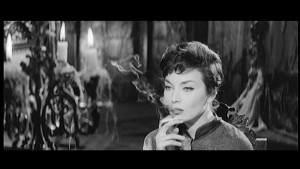 Analysis by a Canadian: Rhett Miller
Analysis by a Canadian: Rhett Miller
More than any other determinate, we consistently blame censorship for all the problems facing cinema. The Hayes code, the HUAC, the MPAA, such titles carry with them connotations of destroying the freedom of expression the arts require, forcing visionaries to sanitize their ideas and statements in order to cater to a family-friendly crowd. While these connotations are no doubt true to a point, I would wager to argue that censorship has also indeed been the driving force of some of cinema’s greatest achievements.
Evolution comes from roadblocks. A newly blinded man is forced to rely on other senses when his eyes escape him, causing the mind to devise newer and more advanced methods at processing the environment. Similarly, when cinema is faced with the disability of censorship, its senses – the casts, the crews, the filmmakers – are forced to find new ways to go about doing things. Out of the Hayes code came Citizen Kane, an attack on big business funded by big business. Out of the HUAC came On The Waterfront, a communist think piece and a parable about caving in to the cruel hand of censorship. Out of the MPAA came Bonnie & Clyde, using graphic violence to express the Vietnam mess with a newly visceral approach. Despite its limiting intent, censorship paradoxically inspires its victims to work even harder at subverting it, to the point where cinema is forced to take great leaps into how films are made. If everyone had the freedom to make whatever they wanted, there would be little motivation to push boundaries or to experiment. But when you put limits, people will try to break them, like records set and broken at the Olympics. Censorship may work at keeping the majority of films under content control, but the rare few that are able to counteract censorship, to break through its boundaries, are the ones that often lend a hand in changing cinema as we know it.
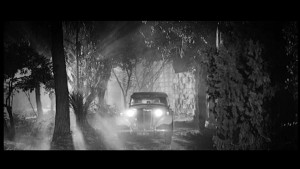 Although not nearly on as potent a level as Citizen Kane or Bonnie & Clyde, Mario Bava’s I Vampiri also used the looming threat of censorship to bring about a change in Italian filmmaking. Following Italy’s embarrassing loss in World War II, their cinema was faced with unprecedented suppression. Horror films were banned, which does not sound like such a bad thing, but considering the cathartic post-war release that Germany’s expressionist horror films served Germans after World War I, such restrictions very much kept Italy in the dirt much longer than it should have been. Instead of documenting the disillusionment facing the nation or the government rot that occurred, the cinema was whitewashed, and so were the people. Governments may have tried to project an allure of control, but deep down a rot was festering. So finally, when Bava broke out with Italy’s first post-war horror film, I Vampiri, he was able to express the sentiment of a nation of disillusionment, and in so doing define the look, feel and structure of Italian films to follow for several years, from Argento to Fulci.
Although not nearly on as potent a level as Citizen Kane or Bonnie & Clyde, Mario Bava’s I Vampiri also used the looming threat of censorship to bring about a change in Italian filmmaking. Following Italy’s embarrassing loss in World War II, their cinema was faced with unprecedented suppression. Horror films were banned, which does not sound like such a bad thing, but considering the cathartic post-war release that Germany’s expressionist horror films served Germans after World War I, such restrictions very much kept Italy in the dirt much longer than it should have been. Instead of documenting the disillusionment facing the nation or the government rot that occurred, the cinema was whitewashed, and so were the people. Governments may have tried to project an allure of control, but deep down a rot was festering. So finally, when Bava broke out with Italy’s first post-war horror film, I Vampiri, he was able to express the sentiment of a nation of disillusionment, and in so doing define the look, feel and structure of Italian films to follow for several years, from Argento to Fulci.
The plot is incredibly simplistic: an aging woman refuses to address her wrinkles, and instead employs a team of scientists to take the beauty from young girls in order to keep her looking presentable on the outside. What the movie lacks in complexity it makes up in parable, the aging Duchess Du Grand being the embodiment of Italy, her henchmen the government and the beautiful girls Italy’s youth. On the outside, the Duchess may seem presentable, but inside she is dead, hollowed by oppressing her problems and her age. Like Italy, she refuses to acknowledge the winkles, bruises and imperfections that war has brought her, and instead tries to cover up a wound with empty appearances. Her henchman try to cover everything up for her, but it is clear that what they are doing is harming the nation more than it is helping it. By killing the youth to momentarily preserve the decrepit status quo, the Italian government forego the future in order to sustain an outdated past. It is no surprise that when the Duchess finally comes clean and dies, the country becomes a better place, as the youth find love and hope begins to shine in from the darkness of conspiracy.
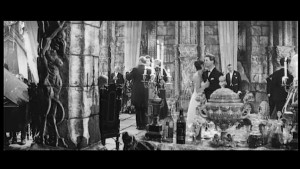 The film is cloaked in allegory to Italy’s political situation at the time, and Bava was no doubt using the parable to address his country and the governmental system that had censored the arts for so long. The government suppressed horror films in favor of lighter cinematic fare, just like the suppressed their post-war problems by trying to project an illusion of tranquility across the nation. Bava shows with Vampiri that no matter how hard one tries to maintain appearances, the truth eventually comes out, and the sooner it does, the better everyone becomes. The sooner that horror films are allowed and able to project the fears and concerns of a society, the sooner that society can come to terms with its insecurities. I Vampiri speaks to its youthful target, exposing the decay facing Italy, but at the same time offering hope. “Every time I see her she looks even more beautiful,” a man says of one of the beautiful girls in the film, concluding with “I don’t know how she can live in a place like this.” Italy was full of rot, but Bava was still able to see a light of possibility for Italy, and for the arts.
The film is cloaked in allegory to Italy’s political situation at the time, and Bava was no doubt using the parable to address his country and the governmental system that had censored the arts for so long. The government suppressed horror films in favor of lighter cinematic fare, just like the suppressed their post-war problems by trying to project an illusion of tranquility across the nation. Bava shows with Vampiri that no matter how hard one tries to maintain appearances, the truth eventually comes out, and the sooner it does, the better everyone becomes. The sooner that horror films are allowed and able to project the fears and concerns of a society, the sooner that society can come to terms with its insecurities. I Vampiri speaks to its youthful target, exposing the decay facing Italy, but at the same time offering hope. “Every time I see her she looks even more beautiful,” a man says of one of the beautiful girls in the film, concluding with “I don’t know how she can live in a place like this.” Italy was full of rot, but Bava was still able to see a light of possibility for Italy, and for the arts.
As much as the subject matter conveys the masquerade that the Italian government was attempting to pull on all its citizens, Bava does the same thing with set design. A cinematographer at heart, Bava is a man who speaks most potently through visuals. It is with his contrast between the light, orderly and beautiful exteriors and the dark, expressionistic interiors that Bava makes the dichotomy between the feelings of the Italian government and the Italian people most vivid. As much as the exterior cinematography suggests peace and harmony, the interiors of the same locations suggest a world brooding with uncertainty, decay and darkness. With every light there is a shadow, and it is in the shadows that Bava demonstrates the essence of post-war Italy. The shadowed visuals come to life with an expressionist glee, the contorted railings, window sills and silhouettes all suggest something unkempt lurking beneath the surface of the Italian people. Bava transplants the German expressionist aesthetic with a gleeful excitement, and never has coming to terms with wartime ruin been so fun, and so accessible.
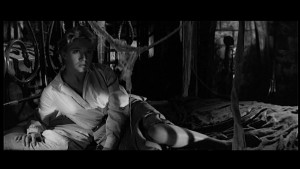 The film is no Nosferatu, but is probably the closest thing the Italians ever got to bringing to light the darkness of their post-war situation. Even if its social commentary has largely been forgotten with Italy’s advancement after World War II, the film will nonetheless be remembered as a starting point for Mario Bava. Without Bava we wouldn’t have Dario Argento, Lucio Fulci, Sergio Martino, Sergio Leone, or any other Italian who worked to elevate the Italian genre film into something much more profound. Bava was a man of style when there really wasn’t any in the cinema, and even today his films bubble with the delight of a man breaking down the walls of his artistic medium. But let us remember that his career was born out of censorship, and Italian cinema is all the better because of it.
The film is no Nosferatu, but is probably the closest thing the Italians ever got to bringing to light the darkness of their post-war situation. Even if its social commentary has largely been forgotten with Italy’s advancement after World War II, the film will nonetheless be remembered as a starting point for Mario Bava. Without Bava we wouldn’t have Dario Argento, Lucio Fulci, Sergio Martino, Sergio Leone, or any other Italian who worked to elevate the Italian genre film into something much more profound. Bava was a man of style when there really wasn’t any in the cinema, and even today his films bubble with the delight of a man breaking down the walls of his artistic medium. But let us remember that his career was born out of censorship, and Italian cinema is all the better because of it.
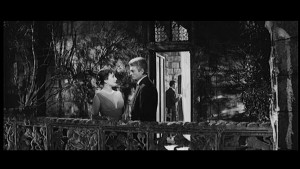 Analysis by an American: Shawn McLoughlin
Analysis by an American: Shawn McLoughlin
I Vampiri is said to be the first Italian horror film of the sound era. Too bad it couldn’t have been a tad more memorable. The main problem that lies with the movie isn’t in the direction, the acting or any of the other usual suspects. Simply put, it just isn’t very engaging, and the story goes nowhere. Possibly my expectations were just a tad too high, but regardless, I feel deceived by not actually getting a vampire in this movie. Hell, you don’t even get a real “horror” film for that matter.
With Bava behind the camera while Riccardo Freda was asleep in the director’s chair one would presume there would be a lot of interesting visuals. In many cases there are. There are close-ups and shoulder shots of a figure with black gloves which will become trademarks for his (and everyone else’s) giallo films that will follow. But if you take out the Bava cinematography, which is unsurprisingly amateurish, compared to his later efforts, what is left? There are sets, yes. The sets are quite lovely. The family crypt has a very atmospheric air about it that is only helped by the silly 50’s practice of covering every crypt with skulls and various bones. The evil lair even comes equipped with a very elaborate secret laboratory complete with a requisite limping “Igor” type character. So it has some style, just nothing near original. The camera is pretty stiff and there are quite a few minutes that go by with nothing visually exciting happening at all. Perhaps this was just because Bava was essentially the apprentice on this set and hasn’t settled into his own routine. Whatever the reason, it is the audience that suffers.
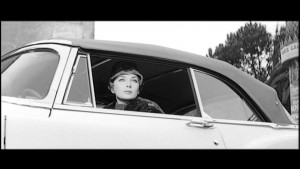 All things considered at least some credit should be given to the filmmakers for making it at least viewable. Being the first horror film in many years they really didn’t have much to go off of. The really popular Hammer Studios horror films haven’t started circulating yet so all they had to go by was American films. I Vampiri is almost exactly like the later sequels to the Universal monster films such as Ghost of Frankenstein and Son of Dracula. A crime is committed in the first act. A detective or police officer or some other authority figure finds something suspicious thing happening, and no one believes a word of it. The last act is entirely surmised of explanation through “this is how I found out” detective nonsense. That formula is followed word for word here. Throw a few trench coats on our hero and have the evil female act like Norma Desmond and smoke just because it looks good in black and white. Yep, we got that. There are some super-cool transformation scenes though as our Evil “Countess Bathory-ish” Duchess ages that the effects team was no doubt satisfied with. But I can’t imagine anyone being particularly proud of the film.
All things considered at least some credit should be given to the filmmakers for making it at least viewable. Being the first horror film in many years they really didn’t have much to go off of. The really popular Hammer Studios horror films haven’t started circulating yet so all they had to go by was American films. I Vampiri is almost exactly like the later sequels to the Universal monster films such as Ghost of Frankenstein and Son of Dracula. A crime is committed in the first act. A detective or police officer or some other authority figure finds something suspicious thing happening, and no one believes a word of it. The last act is entirely surmised of explanation through “this is how I found out” detective nonsense. That formula is followed word for word here. Throw a few trench coats on our hero and have the evil female act like Norma Desmond and smoke just because it looks good in black and white. Yep, we got that. There are some super-cool transformation scenes though as our Evil “Countess Bathory-ish” Duchess ages that the effects team was no doubt satisfied with. But I can’t imagine anyone being particularly proud of the film.
Perhaps it was easy to market this film simply because of the lack of horror in Italy. The fact that enough film noir elements were left in might have made it a bit more fashionable too. But mostly it is just boring. I guess they needed something to get the horror-ball rolling a bit, but what is really interesting is that it didn’t get that ball rolling at all. No other horror films come to mind that may have been inspired by this one. Bava went on to make much more violent giallo films with others like Argento following that path. Fulci and others went for more extreme gore. I Vampiri doesn’t go anywhere, but at least it brought horror to Italy which, in turn, brought a LOT of better horror to a lot of people.
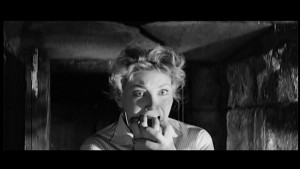 Analysis by an elitist: Adam Lippe
Analysis by an elitist: Adam Lippe
It would be quite a daunting task to be the first to bring horror movies to Italy all by yourself. The urge to pack as many sub-genres in as possible, exposing as many things as you could to prospective audiences would be tempting – possibly enough to overlook the basics of plot logic, photography and coherency. I, Vampiri, as the first Italian horror film of the sound era, manages to squeeze in all it can into its brief 78 minutes, eschewing all notions of sensible filmmaking. Perhaps the filmmakers were too excited to settle down and focus.
These issues find their way into virtually every scene. Right away, the “hero” reporter finds a major clue, a shoe of a kidnapped dancer, and moves it, just to smugly point it out to the policeman. It would appear that he is supposed to be far more clever and cunning than the cop as opposed to just an idiot for tainting evidence by touching it and then moving it from its original place, disrupting the crime scene. However, this pales in comparison to the numerous contrivances we are expected to swallow in order for the plot to function. Is the viewer supposed to believe that Pierre is really tricked by having a barricade moved over one house as he is following his suspect? Or did those who knew he was on their trail move the barricade, knowing that’s how he identified it? Is it customary for blind men to request young girls to hand deliver letters for them (if he can’t see, and isn’t exactly competent or mobile, didn’t she question how he wrote it at all?) to apartments far away? Would the woman just walk in and not be confused that they were expecting her, asking her to sit down and make herself at home? How long does it take to clear out an apartment in Paris? Apparently they managed to in a very small amount of time, without even so much as a vehicle in sight. Is the Igor-looking assistant good at moving furniture? Does his limp get in the way?
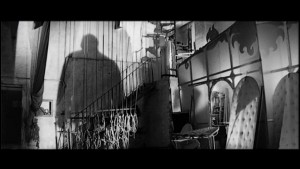 The fact that there is an Igor character at all is a giveaway that Bava and Freda were trying to cram too many horror archetypes into their plot. There are so many scenes of exposition, characters needing to explain exactly what happened off-screen, mostly because the story isn’t clear until the final moments, that it might have been a better idea to simplify the Frankenstein/Dracula/Picture of Dorian Gray story. Of course, the conclusion is completely bogged down by this problem. The chief apparently needed to stand center of frame, telling everyone around him how they figured out what we didn’t understand for the previous 75 minutes.
The fact that there is an Igor character at all is a giveaway that Bava and Freda were trying to cram too many horror archetypes into their plot. There are so many scenes of exposition, characters needing to explain exactly what happened off-screen, mostly because the story isn’t clear until the final moments, that it might have been a better idea to simplify the Frankenstein/Dracula/Picture of Dorian Gray story. Of course, the conclusion is completely bogged down by this problem. The chief apparently needed to stand center of frame, telling everyone around him how they figured out what we didn’t understand for the previous 75 minutes.
The general sloppiness is not only limited to the storytelling. It is amazing that someone whose visual sense was as strong as Bava’s could shoot something so bland and flat looking. The lighting is especially puzzling, as all the daytime scenes are blown out and overly bright, lacking contrast in every image. There isn’t a visually interesting frame until Giselle meets Pierre on the balcony during the party. While perhaps it is unfair to judge the stiff acting and blame it on Bava, if he only directed two of the twelve shooting days, but it is odd that the camera never moves, exposing more problems than it would have created, such as when Igor falls down the stairs after being shot, and it is quite obviously a dummy, thumping in the center of frame. The inactivity of the camera is very much in line with how almost none of the major action takes place on screen, and the audience has to be told what has occurred. Even sequences where movement would often be necessary, such as the dancing during the ball, the camera remains still. Whether the inertia is because of a limited budget, or a lack of planning, is not an excuse.
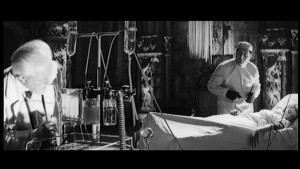 Financial issues may have caused the lack of confidence, however, since horror films were banned in Italy to this point. This was likely caused by the restricted attitudes of the fascist government initially instituted by Mussolini. The problem it created for Bava and Freda is that, in their excitement to bring this genre to a sheltered audience, they could not decide which direction to take the film in. Scads of scenes are left underdeveloped, from the romance angle of the Lantin family, to the man who is enslaved by either feeding him drugs or some other mysterious reason, to whatever experiment the doctor wanted to perform instead of constantly using the bodies of young girls to make his cousin look younger, to whether or not the girls are killed when their bodies are used, etc., all of which makes the film feel scattered and confused, unaware of its own rules, but determined to throw in every convention of the horror genre.
Financial issues may have caused the lack of confidence, however, since horror films were banned in Italy to this point. This was likely caused by the restricted attitudes of the fascist government initially instituted by Mussolini. The problem it created for Bava and Freda is that, in their excitement to bring this genre to a sheltered audience, they could not decide which direction to take the film in. Scads of scenes are left underdeveloped, from the romance angle of the Lantin family, to the man who is enslaved by either feeding him drugs or some other mysterious reason, to whatever experiment the doctor wanted to perform instead of constantly using the bodies of young girls to make his cousin look younger, to whether or not the girls are killed when their bodies are used, etc., all of which makes the film feel scattered and confused, unaware of its own rules, but determined to throw in every convention of the horror genre.
Adam So, I think it should be said, that if I am ever kidnapped and placed in a strange room, when a creepy guy comes at me with syringe, even if I am not restrained, I will not try to avoid him, or even struggle.
Rhett Yes, the parameters of the kidnapping were pretty ludicrous. She never tried remotely to escape at all.
Adam However, I really want to learn how to clear out an apartment so quickly.
Shawn The apartment cleaning montage deleted scene would have been wonderful addition to the DVD.
Rhett As if realizing that, hey, I am kidnapped, therefore the plot will not allow my escape until the leading man bringing down the antagonist, so I will just wait.
Adam Even if my leading man is an idiot who moves around police evidence and then brags about it.
Rhett And even if I have reactions akin to Joshua’s mother in Troll 2.
Shawn He is not an idiot. He is a master detective. “Hey, I found this shoe… you want it?” Could be a clue… A shoe… with no foot in it.
Adam The most important scene in the film was botched when his boss chews him out and puts him on another assignment. That boss really needed to be a cop. And black.
Shawn Hard to walk around without a shoe. You should try it, officer didn’t-find-the-shoe.
Adam More scenes of black chiefs reassigning unruly cops make me cream my pants.
Shawn He should have said “I’m gettin’ too old for this shit.”
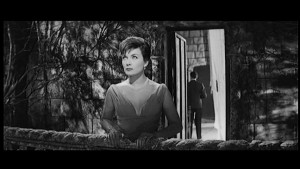 Rhett I took that scene as an allegory to how Italy refused to allow society to face the darker aspects of its war loss, and instead to just present itself as composed and happy via endless dances and banquets. Instead of covering murder, he covers dances.
Rhett I took that scene as an allegory to how Italy refused to allow society to face the darker aspects of its war loss, and instead to just present itself as composed and happy via endless dances and banquets. Instead of covering murder, he covers dances.
Adam And what a lively affair that ball was! The most spectacular since 1929!
Shawn Never has there been such a scene.
Adam Or was it 1925?
Shawn I believe it was 1929. But regardless… never has there been such a non-horror horror film.
Rhett When I watched the film, I kept reminding myself that this was the first Italian film to come out of WWII, so its making should have some significance, like Nosferatu or The Cabinet of Dr. Caligari did to the Germans after WWI.
Adam That does not excuse the sloppy plotting. Maybe the static camerawork and the crammed genre references.
Rhett Static? I’d call it pretty kinetic, especially for 1957.
Adam I thought back and couldn’t remember a single move.
Rhett There are some incredibly elaborate cranes.
Shawn For a while I thought it took at least something from every single Universal classic monster sequel.
Rhett There is actually a lot of movement and some impeccable lighting design in the caverns with the impressionistic shadows filling the walls.
Adam But not when there needed to be such as during the chases, the dance.
Shawn The movie is almost all static Rhett, where the hell were you looking?
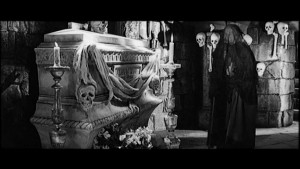 Adam Really? The lighting was awful especially during the day scenes.
Adam Really? The lighting was awful especially during the day scenes.
Shawn Even the ballroom was pretty badly lit.
Adam It was blown out. No contrast at all.
Rhett I think that was the point.
Adam I don’t know, it looked pretty sloppy and rushed.
Rhett To make the differences between the exteriors and interiors more prominent.
Shawn Wasn’t this filmed in 12 days, and the main director was known for not giving a shit. I think that comes across well.
Rhett The Italian government was trying to project a veneer of beauty, but deep down the country was crumbling from the loss of WWII. So outside, on the surface, everything looked clean and white, while inside was a cavern of shadows.
Shawn Everything looked clean outside to you?
Adam While I can see the censorship creeping in, especially in terms of most of the action occurring off-screen. But lazy does not equal stylish.
Rhett Yeah, the outside scenes seemed overexposed, as if to make the contrast between the interiors even more prominent.
Adam I don’t think that much care was taken with any of the mise-en-scène, the framing of the shots is especially dull.
Shawn Or maybe someone just left the can open.
Adam It’s not just the camera that’s static. Everything is flat.
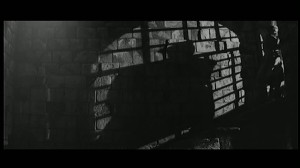 Rhett 1:03:40ish is wonderfully lit, with the shadows of the gate bleeding across the cellar.
Rhett 1:03:40ish is wonderfully lit, with the shadows of the gate bleeding across the cellar.
Adam If that’s the scene on the balcony at the ball between Pierre and Giselle, I agree.
Shawn That was a nice scene – I will agree on that one.
Adam Shawn, it’s when the guy wakes up from the slumber; the one who was dead, or not, and then Pierre sets off the alarm. There’s a nice shadow reflection off the wall.
Shawn What the hell was with that alarm anyway? What was it, shaped like a cat?
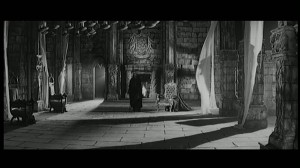 Rhett 29:03 is another great use of shadow. There is incredible depth to all the interiors; I am really surprised you both found it so dull.
Rhett 29:03 is another great use of shadow. There is incredible depth to all the interiors; I am really surprised you both found it so dull.
Adam Honestly, I’ve rarely had a harder time sitting through such a short film
Shawn I wrote that almost line for line in my review, Adam.
Adam It must have been working off of state of the art laser censors. I was willing to give it the benefit of the doubt on the primitive genre explorations and even the stiff acting, but the enormous amounts of exposition killed me.
Rhett I had no trouble at all, the plot was simple but the style was great.
Shawn I am glad that we got to see Giselle smoking for almost a continuous minute.
Adam Simple in theory, Rhett. There was a huge amount going on, none of it developed. Overstuffed FrankenDracuDorianGray.
Rhett And the transformation effects were an impressive Bava trick.
Shawn The transformation was grand for the time.
Rhett It is still damn impressive.
Adam Yes, that was nice.
Rhett No cutaways, no dissolves, he stays with it the whole time. No doubt the precursor to Eyes Without a Face.
Adam The problem with the shot you just outlined, 29:03, it goes on forever. It lingers on itself; she walks across frame for about thirty seconds.
Shawn But while the effect was more impressive in a howdtheydothat way, it didn’t have the emotion that the Cat People transformation or even The Wolf Man transformation has.
Rhett Yes, shots were very long, but that was something I understood came out of a rushed production and a lack of coverage, but something I had no problem looking at.
Adam It’s nice, yes, but it really needed to be 5 seconds.
Shawn I haven’t even seen all of Cat People and I think it is better done.
Rhett I’d rather look at a nice shot for too long than have perfectly cut point and shoot ugliness. Cat People is a much better film, don’t get me wrong.
Adam Well, that depends because once you become aware of the camera, you’re taken out of the movie.
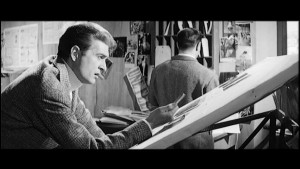 Rhett Well, seeing as the plot is so bare, that is a good device since it gets you thinking about what the shadows mean, what the simple plot is trying to say beneath the surface as a commentary on post-war Italy.
Rhett Well, seeing as the plot is so bare, that is a good device since it gets you thinking about what the shadows mean, what the simple plot is trying to say beneath the surface as a commentary on post-war Italy.
Adam I think it’s only bare in theory.
Shawn I disagree. A fine device maybe, but a device is only as good as the film itself.
Adam There are a huge amount of directions it the movie goes in and just as many questions I had at the end.
Shawn Of course, you will never find any Fulci fan to agree with me on that.
Adam Not so simple. What is it the scientist/cousin really wants to be working on? Is he producing heroin to enslave people? Did he bring that guy back to life? The one with the stitching on his neck.
Shawn The junkie is straight out of Reefer Madness.
Adam Do the girls die when they get — whatever they get done to them? Their essence taken?
Shawn Adam, I read that there was a deleted scene where the guy was killed via guillotine censors cut it, but some stills survived.
Rhett I just assumed they died. The youth being killed to preserve the appearance of the dying past.
Adam But that girl at the end lives despite the fact that she was buried. And he was buried too.
Shawn Well a lot of people had to die in order to get all those decorative skulls. That crypt had more bodies than the Sawyer residence.
Rhett Perhaps she had not been fully drained yet and was still in storage. Plot isn’t really something to pick apart in a Bava film.
Shawn Yeah, but remember Rhett – this isn’t a Bava film. He filmed the last two days worth of production. You can tell when he was behind the camera.
Rhett He shot the whole thing though, as cinematographer.
Adam Which is why the sloppiness of the outdoors is kind of shocking. It is distinctive in its incompetence. It has a rushed, fuzzy, TV look, not something that was shot with care in 2.35.
Shawn There was only a few scenes I could even notice Bava-ness.
Rhett Considering Bava was a master technician, I doubt the look is due to outright sloppiness.
Adam Then what is it?
Rhett It looks like the intent was to be overexposed to make the contrast with the dark labyrinths more pronounced.
Adam But only when using exteriors, such as when they go to the apartment to follow up his lead. At the beginning, when he’s duped by the barricade. That isn’t overexposed. Even though it is, in fact, outside.
Rhett Yes, to make the outside look much more done up than the shadows. Just like the main character, the Duchess, does up her face to mask the darkness in her soul.
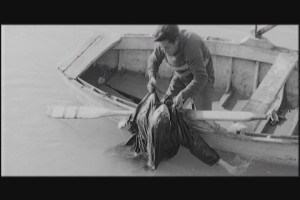 Rhett 2:19 looks pretty overexposed.
Rhett 2:19 looks pretty overexposed.
Shawn I know that it makes me sound less “filmtastic” but I really don’t think near as much thought was put into this film as Rhett mentions.
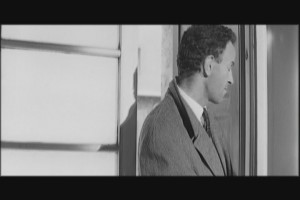 Adam Go to 20:10, overexposed interiors. The lighting on his coat is ridiculous
Adam Go to 20:10, overexposed interiors. The lighting on his coat is ridiculous
Shawn I don’t even think they had a thought of this as the first horror film. It’s just too hodge-podge. At least the horrible Universal sequels tried to convey atmosphere. I just don’t feel it here. Very little outside the newspaper even tells me this is Italy.
Adam It isn’t.
Shawn Or Paris.
Adam That was confusing as well because it’s like he’s hopping back and forth in 20 minutes to see his editor.
Shawn Why set something in a “foreign” area and not try to show that?
Adam He’s reassigned to another story in Paris? Covering a party?
Shawn What else is there to do in Paris?
Rhett Have anal sex with Marlon Brando?
Adam Well, apparently, if you’re caught reading, you’ll get kidnapped. The message is clear, if you’re a young woman in Paris, you should be out partying at the bar, not studying.
Shawn Or at least talking to suspicious, inexpressive reporters. “I really am interested in you sexually, but I am not even going to try to show this.”
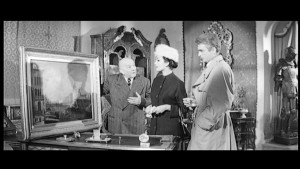 Adam My favorite scene in the whole film had to have been during the party when he hears that girl scream. Wasn’t that a bad time to try to inject with her something? At least wait ‘til the company leaves.
Adam My favorite scene in the whole film had to have been during the party when he hears that girl scream. Wasn’t that a bad time to try to inject with her something? At least wait ‘til the company leaves.
Rhett The crazy aunt excuse was smooth, though. The first time Tourette’s was first hinted at in a mainstream genre film.
Shawn “My crazy aunt… She is just so crazy… she screams… cause she’s crazy. Isn’t that crazy?” I think the kitten put in the most emotional performance. “Yes, come in. I am only locking the door behind you so you don’t steal anything…. that’s it…. look at the kitten. Now I got you!”
Rhett Come on, who is going to make a “pussy” joke?
Adam Hey, imagine how traumatized he was when they moved an entire apartment out around him, with probably nothing more than a guy with a prominent limp?
Shawn “Hey, did we forget the cat?” “Ah… who cares, there is no shortage of pussy/tail in Paris.” At least this film continued to tell everyone that smoking and trenchcoats are cool. Thankfully, Uwe Boll remembered this in Heart of America… Which obviously proves the influence I Vampiri had on cinema.
Rhett Bava is definitely a show-er.
Adam I hope I didn’t influence the spelling of that too much it just didn’t look right as shower. Is there a way to measure the significance of the political climate of Italy at all? The influence of Mussolini or fascism? Do we know why horror movies were banned even 12 years after WWII?
Shawn What was the official reason for the ban of horror films?
Adam I would assume it had to do with the limiting political climate.
Rhett I just assumed that escapism was something that the governments would have wanted to try to save face after the devastation of war.
Shawn Sure, I get that – but even Nazi controlled Germany had fantasy escapism films.
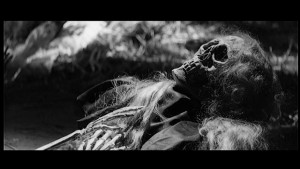 Adam Though it’s odd to quote another film for history, in Bertolucci’s The Conformist is about killing a guy who was not a fascist, simply for his beliefs, not because he was overly outspoken. And he wasn’t even in Italy at the time. Perhaps horror would have been seen as too much escapism.
Adam Though it’s odd to quote another film for history, in Bertolucci’s The Conformist is about killing a guy who was not a fascist, simply for his beliefs, not because he was overly outspoken. And he wasn’t even in Italy at the time. Perhaps horror would have been seen as too much escapism.
Shawn Hitler wanted the occult all to himself. I wonder how successful this film really was. I read that it wasn’t that big of a deal when released.
Adam And what was the real influence of it? Who did it impress enough to give Bava a career?
Rhett Yeah, there really wasn’t much written about it, it seems.
Shawn But I would be surprised that they didn’t market the hell out of it as the first horror film with sound. I still say it was influenced by all the Universal films.
Rhett Well Italy probably had imported sound films before, so it probably wasn’t that big of an event.
Shawn Watch Ghost of Frankenstein and watch this. Almost the same look.
Rhett Yeah, the Universal influence is there, as is the German expressionist.
Shawn Although Ghost of Frankenstein had more production value.
Adam Bava’s first credited film is Black Sunday but that wasn’t til three years later. Then what makes I, Vampiri so special, other than its historical significance?
Shawn Not a goddam thing.
Adam C’mon Rhett, justify your choice.
Rhett It is more stylish than the typical Universal film, and the tone is one with a kind of zeal and energy that had been lacking from the genre. Universal horror was a lot more reserved, more articulate and talky.
Adam More talky than this? I’m not sure that is possible.
Rhett This one relies more on style and seems to express a joy in performing magic tricks to the audience with the effects sequences and some seemingly impossible cranes.
Adam Which crane shots are you referring to?
Shawn I would like to know that too. The only one I can even think of is the ballroom, which pretty much just pans down.
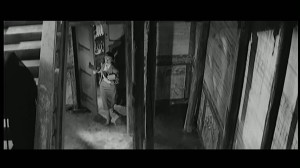 Rhett There are a couple in the stairwell; 30:56, that is a lot of movement for its time.
Rhett There are a couple in the stairwell; 30:56, that is a lot of movement for its time.
Shawn Zeal and Energy are two words I would never use in relation to I, Vampiri. Unless they came after “lack of…”
Rhett Moving down, then up, then around a pillar as it dollies with the stairs.
Adam While the camera moves, it’s pretty herky jerky: the only part that works is that it goes past the pillar. The cut is then awkward.
Rhett Yeah there is that one moment there, but the framing is really nice and it is no doubt ambitious.
Adam It doesn’t justify itself and it’s totally unnecessary. It’s the rest of the movie that needs scope and movement, as opposed to a rather meaningless crane up the stairs.
Rhett I can’t immediately think of any Universal films with the woman as the main antagonist.
Shawn The rest of the movie needs Vampires.
Rhett But that is Bava, that is his style.
Shawn I can think of a Paramount movie with a female as the antagonist. It’s called Sunset Boulevard.
Rhett The entire 90 minute runtime of Danger: Diabolik is unnecessary, but Bava nevertheless has fun with all the style and trickery.
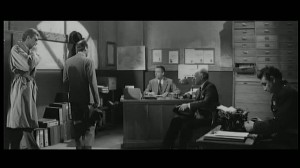 Adam Fast forward to when they have that meeting in the office; 34:30, that scene needed some style.
Adam Fast forward to when they have that meeting in the office; 34:30, that scene needed some style.
Shawn And if you made the male protagonist have any involvement with the film, and took out the faux-vampiristic Countess Bathory metaphor you would have a similar plot.
Rhett Bava probably couldn’t justify 90% of his camera moves throughout his career, but it is the whole that justifies the parts.
Shawn There is no whole here, Rhett.
Rhett His movies exude and energy that is distinctive and different than most horror films.
Shawn Diabolik was PACKED with style.
Rhett You can’t compare a film from 1969 with one from 1957.
Shawn Over-the-fucking-top-can’t-put-the-lid-back-on style.
Rhett Completely different film climates.
Shawn But that is what you are trying to do.
Rhett How?
Shawn By even bringing it up. Forget why it works later on, why doesn’t it work now?
Rhett It worked for me. I am trying to encapsulate his career, not compare his movies.
Shawn But the styles are completely different. In that there is some in that movie and there is hardly any here, and what is, uninspired.
Rhett The camera shots seemed pretty static in the Universal Dracula film compared to Coppola’s Dracula.
Shawn Apples and oranges. Not only because of the times, but because of the theme.
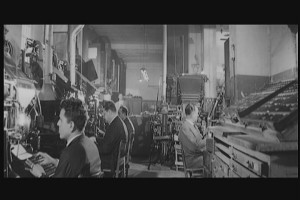 Adam Oh, the stuff at the newspaper; very blown out interiors all of them, 39:15 on.
Adam Oh, the stuff at the newspaper; very blown out interiors all of them, 39:15 on.
Shawn Hey, you do get the requisite spinning headlines though.
Rhett Yeah, that scene is pretty ugly.
Adam It’s so overlit that his hair doesn’t even appear blond redhead it gets worse in the meeting
Rhett Still, more or less just exceptions.
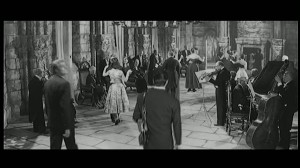 Adam The ball is overlit in the following scene. Look at the establishing shot, awful. When the old lady is talking? Equally bad. The cuts back and forth between Pierre and Giselle? 42:45? All overlit, pretty much everything before he goes on the balcony.
Adam The ball is overlit in the following scene. Look at the establishing shot, awful. When the old lady is talking? Equally bad. The cuts back and forth between Pierre and Giselle? 42:45? All overlit, pretty much everything before he goes on the balcony.
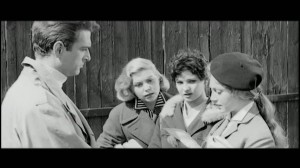 Rhett Not that bad. It isn’t nearly as overexposed as the daylight exteriors at 12:12.
Rhett Not that bad. It isn’t nearly as overexposed as the daylight exteriors at 12:12.
Adam No, but the point is, there’s nothing distinctive about them either. You claim it was a statement he was making with all the interiors especially inside the castle when that obviously isn’t true.
Rhett With the cavernous scenes; the ball scene is still a social outing one that relies on facades and appearances.
Adam Certain scenes have a look but it is not consistent.
Rhett But in the backrooms and the beds those scenes have shadows that suggest a depravity lurking. Pretty consistent.
Adam All this talk about overlighting/overexposure, timecodes and screenshots… So sexy.
Rhett I’m hard.



